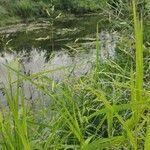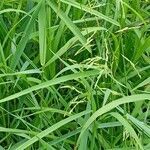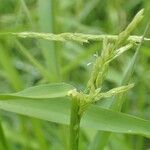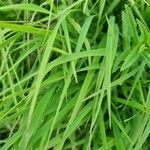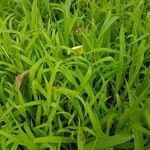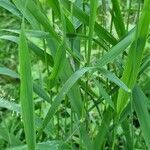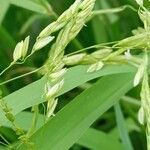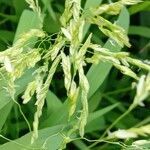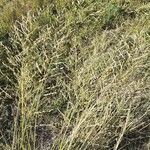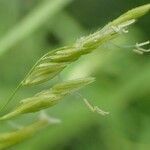Perennial, loosely tufted, with slender rhizomes. Culms weak, decumbent, rooting at lower nodes, upper part up to 120 cm tall, branching near base, scabrid below panicle, nodes retrorsely hispid. Leaf sheaths longer to slightly shorter than internodes, the upper retrorsely spinulose; leaf blades thin, 7–30 × 0.6–1 cm, scabrid on both surfaces, margins scabrid and spinulose, apex acuminate; ligule 1–2 mm, truncate. Panicle lax, ovate in outline, 10–20 cm; branches 1–3 per node, spreading, up to 10 cm, flexuous, very slender, scabrid, lower part long naked, upper part with branchlets bearing spikelets overlapping along one side of branchlets. Spikelets elliptic-oblong, 5–6 mm, whitish with green veins; lemma conspicuously pectinate-hispid on keel and margins, surface strigillose, sometimes sparsely, apex abruptly contracted, subacute. Stamens 3, anthers 1.5–2 mm. Fl. and fr. Jun–Sep. 2n = 48, 60.
Culms decumbent and sprawling, rooting at the nodes, distally erect, to 15 dm; sheaths roughly retrorse-scabrous; ligule truncate, to 1 mm; blades very rough-margined with stiff colorless spinules, the main blades 15–30 cm × 6–15 mm; panicles pale green or whitish, the terminal one to 30 cm, exserted or partly included, its slender branches ± spreading when exserted; lower part of the panicle with 2 or 3(4) branches per node; spikelets ascending, 4–7.5 mm, a fourth to a third as wide, imbricate in spike-like clusters of 3–8 ending the branches; lemma pilose, stiffly ciliate on the keel; stamens 3; late-season axillary panicles reduced and ± included in the sheaths; 2n=48. Swamps, wet meadows, and muddy soil; Que. and N.S. to B.C., s. to Calif. and Fla.; Europe; e. Asia. Estuarine plants vary to a flaccid, virtually glabrous phase with included panicles.
Aquatic perennial, rhizomatous. Culms decumbent to erect, to 1.5 m long. Leaves: basal sheaths compressed, retrorsely scabrous; ligule 0.5–1.5 (–2) mm long, firm; blade (3–) 8–30 (–45) cm long, 3–11 (–15) mm wide, usually scabrous to spiny. Panicles mostly 10–30 cm long, open, with branches spreading at maturity. Spikelets (4–) 4.5–8 mm long. Floret: lemma ellipticoblong to obovate, (4–) 4.5–8 mm long, obtuse to acute and usually apiculate-mucronulate, with 5 scabrous to hispid or ciliate nerves, the stiff hairs to 0.6 mm long on keel but shorter on marginal nerves and fairly inconspicuous on lateral nerves, often scaberulous between nerves; stamens 2 or 3, anthers usually 1–2.2 mm long.
